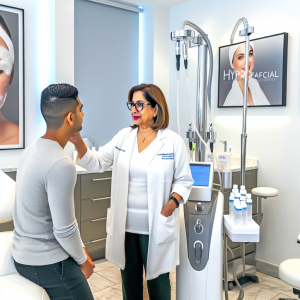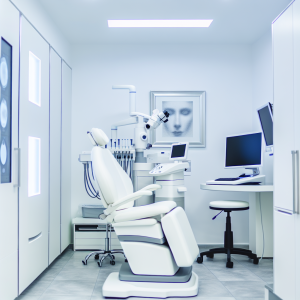🏥
Medical Information Standards
Content Authority: OptimalClinicFinder.com is a comprehensive medical directory platform connecting patients with qualified Botox providers. Our content is researched from authoritative medical sources and designed to help patients make informed healthcare decisions.
How Botox Works: Clinical Mechanism and Applications
Botox (onabotulinumtoxinA) is a purified protein derived from Clostridium botulinum that works by temporarily blocking nerve signals to targeted muscles. When injected into specific facial muscles, Botox prevents the release of acetylcholine, a neurotransmitter responsible for muscle contractions. This controlled muscle relaxation reduces the appearance of dynamic wrinkles—lines that form from repetitive facial expressions like frowning, squinting, and raising eyebrows.
The treatment’s precision allows skilled practitioners to selectively target problem areas while preserving natural facial expressions. Common treatment areas include forehead lines, crow’s feet, frown lines between the eyebrows (glabellar lines), and increasingly, areas like the neck, jawline, and around the mouth. The key to successful outcomes lies in proper dosing, accurate injection placement, and understanding individual facial anatomy.
💡
Did You Know?
Clinical studies show that Botox patients achieve excellent results when combined with professional-grade aftercare products.
Clinical Research and Evidence Base
The clinical development of Botox for cosmetic applications spans over three decades of research, including landmark studies like the pivotal trials that led to FDA approval in 2002. These comprehensive studies enrolled over 1,600 participants and followed patients for up to 12 months, demonstrating consistent safety and efficacy across diverse demographics and age groups.
Subsequent real-world studies involving more than 100,000 patients have confirmed the medication’s safety profile and effectiveness. Research shows that 96% of patients experience significant improvement in wrinkle severity within two weeks of treatment, with results lasting an average of 3.5-4 months. Long-term studies indicate that regular Botox treatments may help prevent the formation of new wrinkles by reducing repetitive muscle movements that contribute to skin creasing.
Treatment Protocols and Clinical Management
Successful Botox treatment begins with a thorough consultation to assess facial anatomy, muscle movement patterns, and patient goals. Experienced providers evaluate factors like skin thickness, muscle strength, asymmetries, and previous treatment history to develop personalized injection strategies. The treatment planning process includes discussing realistic expectations, potential risks, and post-treatment care.
The standard treatment protocol involves precise injection placement using ultra-fine needles to minimize discomfort and reduce injection site reactions. Most sessions take 10-20 minutes, with providers typically using 20-65 units of Botox depending on the treatment areas and individual requirements. Proper injection technique includes specific depths, angles, and spacing to ensure optimal distribution and natural-looking results while avoiding complications like ptosis or brow asymmetry.
💡
Quick Tip
Botox works best when combined with healthy lifestyle choices for optimal results.
Safety Profile and Risk Management
Botox has an excellent safety profile when administered by qualified practitioners, with serious adverse events occurring in less than 1% of treatments. The most common side effects include temporary injection site reactions like mild swelling, bruising, or redness that typically resolve within 24-48 hours. Headaches may occur in approximately 1-3% of patients, usually resolving within a few days.
Rare but serious complications can include eyelid drooping (ptosis), which occurs in less than 5% of treatments and typically resolves within 2-8 weeks. Allergic reactions are extremely uncommon, affecting fewer than 0.1% of patients. Risk factors for complications include improper injection technique, inadequate provider training, use of counterfeit products, or treatment of patients with certain medical conditions like myasthenia gravis or Lambert-Eaton syndrome.
Cost Analysis and Value Considerations
The cost of Botox treatment varies significantly based on geographic location, provider expertise, practice overhead, and treatment complexity. Pricing structures typically follow either per-unit pricing ($10-20 per unit) or per-area pricing ($300-600 per treatment zone). While per-area pricing may seem more predictable, per-unit pricing often provides better value for patients requiring precise dosing adjustments.
When evaluating costs, consider the total value proposition including provider credentials, consultation quality, product authenticity guarantees, and follow-up care. Experienced injectors may charge premium rates but often deliver superior results with lower complication rates, potentially reducing long-term costs associated with correction procedures or suboptimal outcomes. Some practices offer package deals or loyalty programs that can provide cost savings for regular treatments.
Provider Selection and Treatment Access
Choosing the right Botox provider is crucial for achieving safe, natural-looking results. Look for board-certified dermatologists, plastic surgeons, or facial plastic surgeons who specialize in aesthetic treatments and have extensive experience with botulinum toxin injections. Important qualifications include medical board certification, specialized training in facial anatomy, membership in professional organizations like the American Society of Dermatologic Surgery, and a portfolio of before-and-after photos demonstrating consistent results.
⚠️
Safety First
Always consult a qualified medical professional before starting Botox. Results vary by individual.
✓
Why Choose Botox?
●
Clinically proven
●
FDA approved
●
Minimal downtime
●
Long-lasting
Red flags to avoid include non-medical providers, ‘Botox parties’ in non-medical settings, significantly below-market pricing that may indicate diluted or counterfeit products, and providers who cannot provide proper credentials or facility licensing. Quality providers will always conduct thorough consultations, discuss risks and benefits, provide detailed aftercare instructions, and offer follow-up appointments to monitor results and address any concerns.
Best Botox Near Me: Geographic and Access Considerations
When searching for the best Botox near me, consider both proximity and quality factors. Urban areas typically offer more provider options and competitive pricing due to market saturation, while rural areas may have limited choices but potentially more personalized care. Metropolitan areas like New York, Los Angeles, and Miami often feature the latest techniques and technologies but may command premium pricing.
Consider travel time for initial treatment and follow-up appointments, as some patients may need touch-ups or want to address concerns within the first few weeks. Many patients find that the best Botox near me isn’t necessarily the closest provider, but rather the most qualified practitioner within a reasonable distance who offers the expertise and results they desire.
Optimizing Results and Long-term Success
Achieving optimal Botox results requires active patient participation in the treatment process. Pre-treatment preparation includes avoiding blood-thinning medications and supplements for 1-2 weeks when medically appropriate, staying well-hydrated, and arriving with clean skin free of makeup. Post-treatment care involves avoiding exercise for 24 hours, remaining upright for 4 hours, avoiding facial massage, and following provider-specific aftercare instructions.
Long-term success with Botox treatments involves maintaining consistent appointment schedules before full muscle movement returns, typically every 3-4 months initially. Many patients find they can extend treatment intervals over time as muscle memory diminishes. Combining Botox with complementary treatments like dermal fillers, chemical peels, or professional skincare can enhance overall aesthetic results and skin health, creating a comprehensive anti-aging approach that addresses multiple concerns simultaneously.
📚 Medical Authorities & Professional Standards
All Botox procedures should be performed by licensed medical professionals following established clinical guidelines and safety protocols.
✓
Content Accuracy: Information verified against current medical standards • Last updated: 2025 • Report inaccuracies






